When the lightning flashed, I could see the bodies of three Confederates lying only a few yards from me
"The ground had been fought over a day or two before and when the lightning flashed, if I looked a little to my left, I could see the bodies of three Confederates lying only a few yards from me."
A Wisconsin Sergeant Remembers the Battle of Stones River
The following account written by Sergeant Edward Fenton McGlachlin of Co. K, 1st Wisconsin Infantry was featured in the December 24, 1929 issue of the Stevens Point Journal (Wisconsin); it is notable as being one of the few published accounts from the 1st Wisconsin of the Stones River campaign and was one of the last accounts from an eyewitness to see publication.
McGlachlin was born in Watson, New York in 1840 and moved to Wisconsin in 1857. He served three years with the 1st Wisconsin, and spent over a year in Confederate prisoner of war camps after being captured on the second day of Chickamauga in September 1863. After the war, he returned home to Wisconsin, learned the printer's trade, and garnered a solid reputation as a newspaper editor. His son and namesake Major General Edward Fenton McGlachlin II graduated from West Point in 1889 and led the First Division of the A.E.F. in World War I. The senior McGlachlin died in 1931 at age 90 in Stevens Point, Wisconsin.
Sixty-seven years ago
(Christmas Day 1862) the Army of the Cumberland comprised of about
40,000 men under the command of General William S. Rosecrans was
encamped in or within a radius of a few miles of Nashville,
Tennessee. On the same day the Rebel army also comprising about
40,000 men under the command of General Braxton Bragg was encamped at
or in the vicinity of Murfreesboro, Tennessee. “Peace on earth-
good will to men.”
The next day, December
26, General Rosecrans put his whole army in motion, his purpose being
to attack and drive General Bragg and his army out of that part of
Tennessee- and within the next seven days more than 17,000 of the men
who had spent Christmas at or in the vicinity of Nashville or at and
in the vicinity of Murfreesboro had been either killed or wounded.
And the majority of these men who were killed or maimed were under 25
years of age.
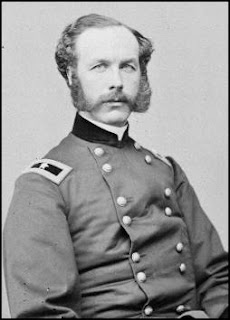 |
| Colonel John C. Starkweather 1st Wisconsin Infantry |
The Union army was
divided into three corps, each comprised of a number of divisions,
brigades, and regiments. General McCook commanded the corps on the
right, General Thomas the one in the center, and General Crittenden
the one on the left. The Union army advanced, their movements being
arranged as nearly as could be foreseen by the commanding general so
that while covering an area of several miles they would be within
supporting distance, should either meet with serious opposition from
the enemy.
Of course both armies had
pickets, videttes, scouts, and cavalry out, each watching the
movements of the other as closely as possible and although when in
camp the armies were nearly 30 miles apart when the advance commenced
the distance between heir outposts was only three or four miles. The
1st Wisconsin Infantry, the one in which I was carrying a
musket, was attached to a brigade in General Thomas' corps and we had
not marched more than six miles out of Nashville before we heard the
booming of cannon, sometimes to the right, sometimes in front,
sometimes to the left. Our advance had struck the Rebel outposts and
was pushing them back.
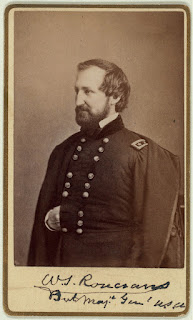 |
| Major General William S. Rosecrans |
History, in giving an
account of this advance and the Battle of Stones River, says that
General Starkweather's brigade (Starkweather was a Milwaukee man and
formerly colonel of our regiment) was temporarily detached from the
corps and sent to another road to watch the movements of the enemy.
How well I remember that incident. We had halted by the side of the
road when General Rosecrans and his entire official staff, escorted
by about 500 cavalrymen, rode by, going to the front. Although I
served in that department more than two years with my regiment and
marched hundreds of miles, that was the only time I ever saw the
commanding general. That night the general conferred with his corps
commander and the next day a cannon ball barely missed him and
carried off the head of his chief of staff who was riding by his
side.
After marching all night
General Starkweather's brigade, mentioned above, reached its
destination in the morning and when we were preparing our breakfast
of coffee, hardtack, and bacon, firing was heard a little distance
down the road. The Rebel cavalry had attacked our supply train.
Rushing down there at the double quick we drove the Rebels off, but
not until they had wounded some of our men and destroyed a number of
our wagons. The commissary of my company was among the wounded and
later in the day I was appointed in his stead.
We had not much more than
got through with the above incident when we were confronted with
another. We saw about a hundred soldiers coming from toward the
front. Most of them were afoot but some were riding artillery horses,
the harnesses from some of which had been removed. All were in a high
state of excitement and they said our army was “all cut to pieces,
all cut to pieces.” I asked two of them who were walking together
to tell me about it. One of them halted a little and seemed inclined
to stop but the other one said, 'come on, come on.' He couldn't stop.
Like the others he was on his way to Nashville nearly 30 miles away,
but General Starkweather put a guard across the road and stopped them
in their mad flight. Were those men cowards? I do not know, but I do
not think so, certainly not all of them. But they were badly
panic-stricken and a panic is what experienced officers most dread
when commanding troops who are receiving their first baptism of fire.
Some of the heaviest fighting of the entire battle had occurred in
the morning and hundreds of men had been killed or wounded. At
daylight the Rebels had advanced in massed formation and in great
force. The blow was a severe one and the result was that the right of
the Union forces, General McCook's corps, was hurled back, at some
points on the line to a considerable distance. The army was not all
cut to pieces but it was badly cut up and it was only by the most
heroic and stubborn fighting that it was saved from defeat.
Leaving the place where
our supply train was attacked and the stragglers stopped, the brigade
moved to another part of the field, but having been appointed company
commissary I remained with the train that night. My duty was to draw
rations from the regimental commissary and issue them to the members
of my company. The next morning I drew some rations, secured a mule
team and a driver, and started on the road to find the regiment. I
finally located the regiment but just as I did so a Rebel battery
opened fire and the guns happened to be pointed in the direction of
our wagon. As a result a number of shells came hurtling through the
air close to us. I had with me two Negro boys. They had attached
themselves to our company, one of them as cook and servant to the
captain. Three or four of us fed and clothed the other one and when
in camp he performed such duties for us as he was able to, built
fires, helped cook, carried water, etc. These I told to take the
rations from the wagon and come with me. But the oldest was badly
frightened. 'Can't go up da, massa, can't go up da.,' he said. 'Our
regiment is not up there,” I answered pointing toward where the
shells were coming from, 'it is over here.' Then I made both take all
the rations they could carry, but as soon as we reached the regiment,
the older one put his load on the ground and lit out for the rear-
and that was the last we saw of him until the battle was over. The
other boy also went away but was not badly frightened.
The above incident took
place in January 1863 and again referring to the history from which I
have previously quoted, it says, 'On the morning of the 1st
the brigades of Starkweather and Walker were placed in the front
line, relieving Van Cleve who returned to his position on the left.'
It was not more than 20 minutes after I had issued the rations as
above stated that this movement was made. We marched out past one of
our batteries that was in action and took position in a cotton field;
and that night, with other members of my company, I was on the
picket line. And how it did rain, and it thundered and lightened. The
heavens seemed to weep when the armies were in action. The ground
had been fought over a day or two before and when the lightning
flashed, if I looked a little to my left, I could see the bodies of
three Confederates lying only a few yards from me. They were among
those who had gone down when making that early morning attack to
which I have referred.
As previously stated,
General Bragg's furious attack on the right of our army had failed.
After that there was severe fighting at intervals all along the front
and finally the Rebel general decided to hazard his chances of
victory or defeat upon an attack on the left of the Union lines. I
did not know it then, but history tells us that the signal for the
attack, after all the preparations had been made, was to be one gun
from the center and 4 o'clock in the afternoon was the hour set for
firing the gun. I do not know, however, that that was about the hour
the attack began, for I was where I heard the desultory firing of the
advancing skirmishers and then I heard the booming of many cannon and
the roar of many muskets. It did not seem possible that anyone could
come out of that inferno alive, and many of them did not. Eventually
the attacking columns were driven back and from our position, as it
grew darker, we could see the flash of the guns as our men pressed
forward. About that time an officer rode on a gallop in the rear of
our lines shouting 'We are driving them, I must tell the boys we are
driving them!' No one knew the officer's name but someone suggested
it must be General Excitement. It was certainly was an exciting time.
General Bragg, an able
officer and hard fighter, had ventured and lost; the next night his
army was in full retreat and on January 5, 1863, the tenth day after
the first gun of the campaign was fired, the Union army entered
Murfreesboro, the goal for which it had started. And General Thomas'
corps in which several Wisconsin regiments were serving, led the
advance. There was little or no fighting, however, after January 3rd
one day having been spent in caring for the wounded and burying the
dead. Some of the latter were buried in a trench we had dug for our
own protection in the cotton field to which I had previously
referred.
The 8th
Wisconsin Battery, which was organized at Steven's Point, was one of
the Wisconsin organizations that took part in this battle and Stephen
D. Carpenter, its captain, was killed. Murfreesboro is now a nice
little college town of about 5,000 inhabitants. With my wife I
visited the place a few years ago and went over the battlefield. One
of the shows places at that time was a farmhouse about a mile and a
half from town. After General Bragg's attack on the right of the
Union line which I have previously mentioned, the Rebels humanely
carried six wounded Union soldiers and laid them on the floor of this
house which was within Rebel lines. Later a solid shot from our own
cannon crashed through the house and killed all of the them. The
beautiful national cemetery is another show place. Many years ago the
Union dead were gathered up and buried here. A marker has also been
placed on the spot where General Rosecrans' chief of staff was
killed, and to those who were there during that trying ordeal in the
long, long ago, there are many places of interest.


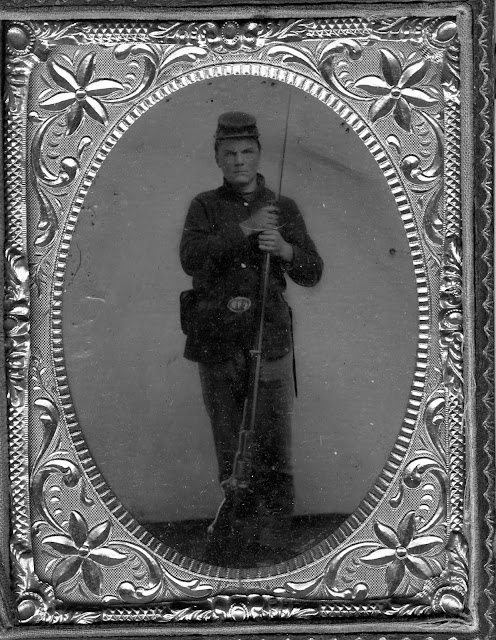
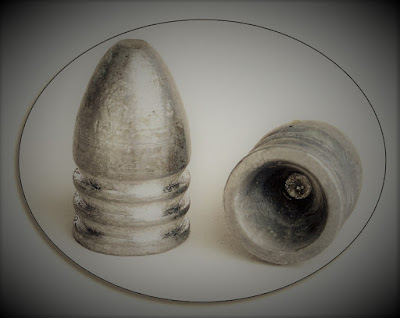




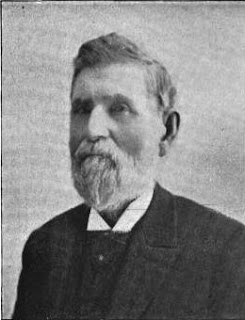


Comments
Post a Comment